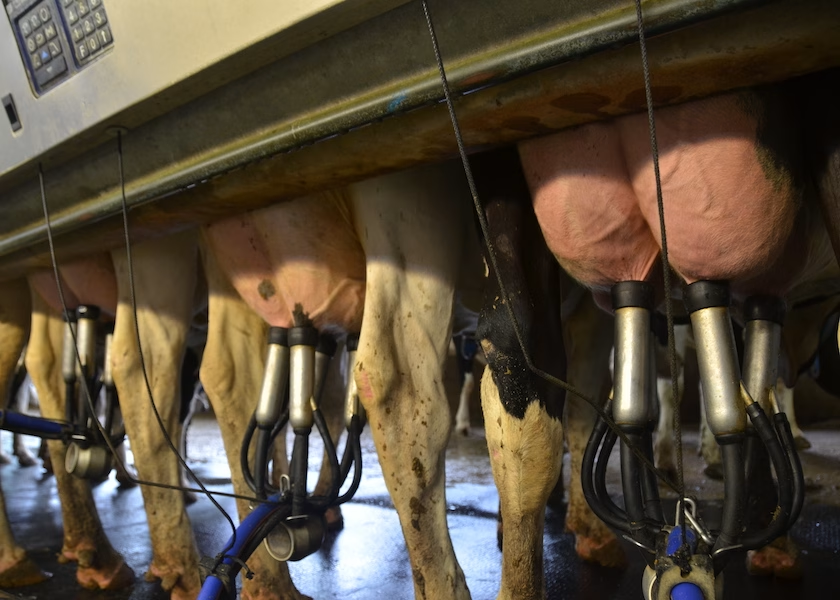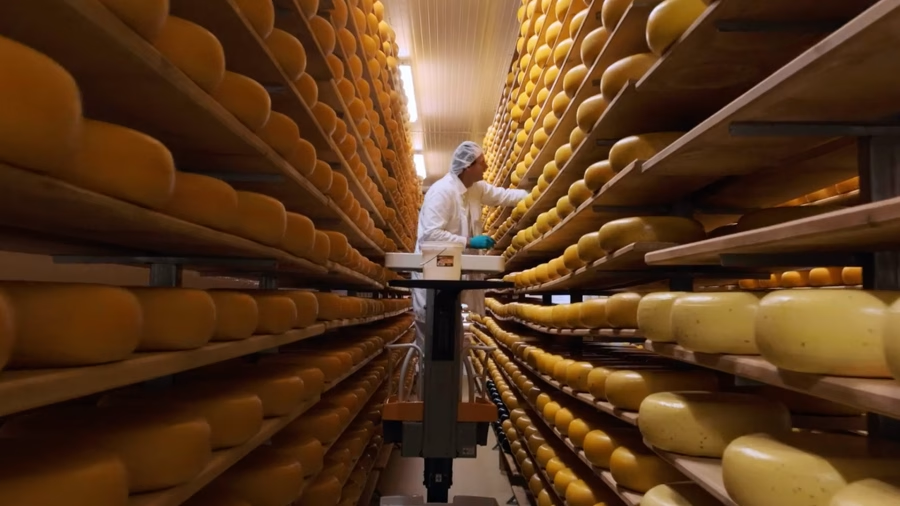Dairy farmers, are you ready to boost your profits? The secret lies in milk solids. Optimizing butterfat and protein production is key as markets shift towards valuing quality over quantity. Discover how innovative nutrition, genetics, and technology strategies can transform your dairy operation and secure your future in the industry.
The focus shifts from milk volume to quality in today’s dairy market. Butterfat and protein, the primary components of milk solids, are currently driving profitability. With strong values for these components, dairy farmers have a unique chance to increase their profits by focusing on strategies that boost milk solids production. This article explores practical strategies, backed by data and expert insights, to assist dairy farmers in taking advantage of this trend.
Understanding the Milk Solids Revolution
Milk solids consisting of butterfat and protein are becoming more valuable in global markets. This change is due to consumers’ preference for higher-quality dairy products and the rising demand for milk in cheese and other value-added products.
Global Trends in Milk Solids Production
| Year | Milkfat % | Nonfat Solids % |
|---|---|---|
| 2010 | 3.66% | 8.80% |
| 2019 | 3.92% | 8.93% |
| 2023 | 4.07% | 8.95% |
| 2024 | 4.22% | 9.11% |
In New Zealand, a leader in milk solids production, the average milk solids per cow increased from 386 kg in 2020 to 400 kg in 2023. This consistent increase demonstrates the influence of enhanced genetics, better feeding techniques, and innovative management approaches.
In the United States, we’ve seen similar improvements:
- Butterfat content in farm milk rose from 3.68% in 2000 to 3.95% in 2020
- Skim solids increased from 8.72% to 8.94% in the same period
These changes indicate a shift in the industry towards enhancing milk component production instead of increasing volume.
Why Focus on Milk Solids?
Higher butterfat and protein levels directly impact farm profits. Here’s why:
- Many processors pay higher premiums for milk with higher butterfat content due to its quality and versatility in dairy products.
- Protein-rich milk is essential for cheese production, which accounts for a large portion of dairy processing.
- With butterfat prices averaging $1.72 per pound and protein prices similarly strong, even minor improvements in component yields can lead to significant financial gains.
Balanced Ration Formulation: The Foundation of Success
A well-balanced diet is key to maximizing milk solids production. Proper nutrition supports rumen health, improves digestion efficiency, and helps cows reach their genetic potential for milk component yields.
| Nutritional Factor | Recommended Range |
|---|---|
| Neutral Detergent Fiber (NDF) | 26-32% of total diet |
| Non-Fiber Carbohydrates (NFCs) | 30-40% of total diet |
| Crude Protein | 16-18% |
| Rumen Undegradable Protein (RUP) | 33-40% of crude protein |
Key Nutritional Factors
- Fiber Levels: Neutral detergent fiber (NDF) should be kept at 26-32% of the diet. This level optimizes rumen function and butterfat production.
- Carbohydrate Balance: Non-fiber carbohydrates (NFCs) should comprise 30-40% of the diet. This provides energy without risking acidosis, which can harm the rumen’s health.
- Protein Precision: Crude protein levels should range from 16% to 18%, with 33% to 40% being rumen undegradable protein (RUP). This supports milk protein synthesis.
Research shows that adequately balanced diets can increase butterfat levels by up to 11% within a year. Regular monitoring of feed quality and adjusting based on herd performance are crucial for achieving these results.
Maximizing Feed Intake: The Key to Component Production
Dry matter intake (DMI) is one of the most critical factors influencing milk solids production. In simple terms, cows must consume better feed to increase their butterfat and protein production.
Strategies for Boosting DMI
- Frequent Feeding: Feeding multiple times a day helps maintain consistent rumen conditions, leading to better digestion and more stable milk component production.
- High-Quality Forage: Palatable, nutrient-dense forages encourage cows to eat more. Focus on harvesting or purchasing forages at the optimal maturity stage for digestibility and nutrient content.
- Tailored Diets: Grouping cows by lactation stage ensures they receive appropriate nutrients at critical times. For example:
- Early lactating cows require up to 30 kg/day of DMI, with crude protein levels around 16.7%.
- Mid-lactation cows need slightly less protein but require high energy levels.
- Dry cows need lower DMI but still benefit from balanced nutrition to prepare for calving.
Farms implementing these strategies have reported daily DMI increases of about 0.5 kg per cow, directly translating into higher milk solids production.
Strategic Supplementation: Fine-Tuning for Peak Performance
Supplementation can significantly enhance milk component yields by addressing specific nutritional gaps or boosting rumen efficiency.
Key Supplements
- Rumen-Protected Fats: These fats increase energy density without disrupting rumen function. They can boost butterfat levels in milk, which is especially useful during heat stress or early lactation when energy demands are high.
- Niacin: Administering 6-12 grams daily may improve milk protein synthesis when feeding high-fat diets. Niacin helps balance energy metabolism and can be particularly beneficial for high-producing cows.
- Yeast Products: Yeast cultures promote rumen health and fiber digestion. By improving the overall efficiency of feed utilization, they can increase milk solids by up to 6%.
- Chelated Minerals: The cow’s body more readily absorbs these minerals. They can support overall health and milk production, indirectly contributing to improved milk solids output.
Farmers who integrate these supplements into their feeding programs often see measurable improvements in butterfat and protein yields within weeks.
Grazing Management: Optimizing Nature’s Bounty
For pasture-based systems, effective grazing management is crucial for maximizing nutrient intake and improving milk solids output.
Best Practices
- Pre-Grazing Yields: Maintain pre-grazing yields of around 1,600 kg DM/ha. This ensures cows consume high-quality forage with optimal nutrient density.
- Balanced Fertilization: Avoid over-fertilization, which can reduce pasture structural fiber content and negatively impact butterfat levels. Work with an agronomist to develop a balanced fertilization plan.
- Rotational Grazing: Move cows regularly between paddocks. This helps maintain forage quality throughout the grazing season and ensures cows always have access to fresh, nutrient-rich grass.
- Mixed Pastures: Consider incorporating legumes like clover into your pastures. These plants can improve overall forage quality and boost protein content in the cows’ diet.
Genetic Selection: Breeding for Better Components
Genetics significantly shape a cow’s capacity for producing high-quality milk solids. Her genetics determine up to 50% of a cow’s potential for producing high butterfat and protein levels.
Breeding Strategies
- Select bulls with strong genetic potential for fat and protein production. Look for proven sires with high Predicted Transmitting Ability (PTA) values for these traits.
- Consider crossbreeding with breeds known for high milk solids, such as Jersey or Fleckvieh. This can introduce beneficial genes into your herd relatively quickly.
- Employ genomic testing to pinpoint the best-performing cows in your herd. This information can guide breeding decisions and help you focus on developing cow families with superior milk solid production.
- Pay attention to other traits that indirectly affect milk solids production, such as feed efficiency, longevity, and overall health.
Precision Feeding Technologies
Modern technology offers powerful tools for optimizing feed efficiency and improving milk component yields.
Examples of Precision Feeding Tools
- Total Mixed Ration (TMR) systems combine all feed ingredients into a single mix, ensuring consistent nutrient delivery. This can help prevent sorting and ensure that each cow receives a balanced diet.
- Automated Feeding Systems monitor individual cow intake and adjust rations accordingly. These systems can help identify cows that may be underperforming or at risk for health issues.
- Feed additives such as probiotics and enzymes enhance nutrient absorption and aid digestion efficiency. These can be particularly useful when feeding high-fiber diets or during periods of stress.
- Milk Component Analyzers provide real-time data on butterfat and protein levels. This information can help farmers quickly adjust feeding strategies to optimize production.
The Impact of Milk Solids on Profitability
Emphasizing milk solids isn’t solely about enhancing quality; it’s also about boosting profits:
- Raising the daily average butterfat by just 1.50 kilograms per animal can add nearly $7,900 monthly income for a 100-cow herd.
- Butterfat content above 4.1% often ensures higher payouts under most pricing systems.
- Protein premiums can significantly boost milk checks, especially in prominent cheese production areas.
With global demand for high-component dairy products like cheese growing, optimizing milk solids has never been more critical for farm profitability.
Economic Analysis: Cost-Benefit of Implementing Milk Solids Strategies
Implementing strategies to boost milk solids production requires investment but can yield significant returns. Let’s break down the potential costs and benefits:
Costs:
- Balanced ration formulation: May increase feed costs by 5-10%.
- Genetic improvements: Initial investment in high-quality semen or embryos.
- Precision feeding technologies: $50,000-$100,000 for a TMR system.
Benefits:
- Increased milk solids production: Potential 5-11% increase in butterfat levels.
- Higher milk prices: Premiums for milk with >4.1% butterfat.
- Improved feed efficiency: Potential savings of $0.50-$1.00 per cow daily.
Example Cost-Benefit Scenario:
For a 100-cow herd:
- Investment in balanced ratio and genetics: $20,000
- Increased annual revenue from higher milk solids: $79,000 (based on $7,900/month for a 1.5kg increase in butterfat)
- Net annual benefit: $59,000
Return on investment could be realized within the first year, with ongoing benefits in subsequent years. However, results may vary based on individual farm conditions and market prices. This analysis demonstrates that while there are upfront costs, the potential long-term benefits of focusing on milk solids production can be substantial for many dairy operations.
Future Trends in Milk Solids Production
As the dairy industry changes, several new trends and technologies are influencing the future of milk solids production:
- Advanced Robotic Milking Systems: Next-generation robotic milkers are designed to increase milking frequency and improve efficiency. By allowing cows to be milked on their schedules, these systems could lead to higher milk solids output.
- AI-Driven Analytics: Dairy management systems use artificial intelligence (AI) and machine learning. These technologies help predict the best times for milk cows, adjust feed formulas, and spot early signs of health problems that could impact milk solids production.
- Precision Nutrition: New feed additives and personalized nutrition plans based on individual cow data are being developed. These innovations aim to maximize milk solid yields while also reducing environmental impact.
- Genetic Advancements: Genomics research is ongoing, focusing on identifying and breeding cows with traits that enhance milk solid production. This could result in cows naturally producing higher levels of butterfat and protein.
- Sustainable Production Methods: Due to growing environmental concerns, technologies that lower the carbon footprint of dairy farming while maintaining or improving milk solid yields are becoming more popular.
- Innovative Processing Technologies: New methods for dewatering and filtering milk, such as those developed in Alberta, Canada, promise to transform the process. These advancements will allow for a more efficient concentration of milk solids.
- Shift to High-Value Products: The dairy industry increasingly focuses on producing high-value products like specialty cheeses and whey proteins, which drives demand for milk with higher solid content.
By keeping up with these trends and carefully adopting new technologies, dairy farmers can more efficiently and sustainably meet future market demands for high-quality milk solids.
Quick Facts:
- Average milk solids per cow in New Zealand rose from 386 kg in 2020 to 400 kg in 2023.
- Balanced rations can increase butterfat levels by up to 11% within a year.
- Yeast supplementation can boost milk solids by up to 6%.
- Early lactating cows require up to 30 kg/day of DMI, with crude protein levels around 16.7%.
- Raising the daily average butterfat by just 1.50 kg per animal can add nearly $7,900/month in income for a 100-cow herd.
The Bottom Line
The dairy industry is evolving, with milk solids emerging as the definitive metric for success. As markets worldwide value butterfat and protein content more, innovative farmers can reshape their farms and make more money.
Dairy farmers can lead this industry shift by using the strategies we’ve discussed, such as better feeding, innovative supplements, improved grazing, and choosing the right cows. These approaches boost milk solids and help keep cows healthy and farms running smoothly.
However, each farm has unique characteristics. What works for one farmer might not work for another. When deciding how to use these strategies, consider your situation, including what your local market wants, your resources, and what you want to achieve in the long run.
As you make changes, don’t be afraid to ask for help. Experts like nutritionists, vets, and dairy consultants can offer valuable advice tailored to your herd’s needs. Their expertise can assist you in refining your approach and maximizing the benefits of prioritizing milk solids.
The path ahead is evident: in a market that values quality over quantity, increasing milk solids is not merely a choice—it is imperative for sustained success. By embracing this change and using targeted strategies, you can help your cows reach their full potential, make your farm more profitable, and secure a strong position in the changing dairy industry.
As you start this journey, remember that even minor improvements in milk solids can lead to significant gains over time. Stay updated, stay flexible, and consistently aim to redefine the limits of what can be achieved in dairy farming.
Key Takeaways:
- Strategic focus on milk solids, particularly butterfat, and protein, can significantly enhance dairy farm profitability.
- Balanced nutrition through fiber, carbohydrate, and protein precision is crucial in optimizing milk components.
- Regular monitoring and tailored feeding strategies are essential for maximizing dry matter intake and overall milk production efficiency.
- Supplementation with rumen-protected fats, niacin, yeast products, and chelated minerals can enhance milk solid yields.
- Effective grazing management and genetic selection are key drivers for improving milk solids output in pasture-based systems.
- Precision feeding technologies, including automated systems and milk analyzers, facilitate optimal nutrition and immediate adjustments.
- Consumer demand for high-quality dairy products drives the shift towards milk solids, creating new profit opportunities for producers.
Summary:
The dairy market is changing fast, now focusing on quality over quantity. Milk solids like butterfat and protein are becoming crucial for making money. By boosting these key components with innovative feeding plans, dairy farmers can increase their profits significantly. This shift is more important as people want higher-quality dairy products, and there’s more need for milk in cheese and value-added items. In places like New Zealand, milk solids per cow have grown due to better genetics and feeding. This means higher profits since milk with more butterfat gets better prices. Giving cows a balanced diet is vital for the best milk solids, as it keeps them healthy and helps them use their full genetic potential efficiently.
Learn more:
- Boosting Dairy Farm Profits: 7 Effective Strategies to Enhance Cash Flow
- Leveraging Dietary Starch and Amino Acids for Optimal Component Yields: Boosting Dairy Cow Productivity
- Top 7 Data Points to Track for Optimal Herd Performance
 Join the Revolution!
Join the Revolution!
Bullvine Daily is your essential e-zine for staying ahead in the dairy industry. With over 30,000 subscribers, we bring you the week’s top news, helping you manage tasks efficiently. Stay informed about milk production, tech adoption, and more, so you can concentrate on your dairy operations.







 Join the Revolution!
Join the Revolution!







